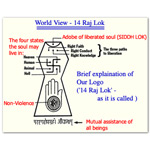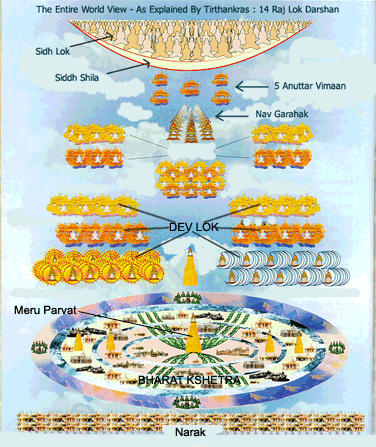

We often see around us many people – rich or poor, thin or fat, beautiful or ugly. We see many animals, things. There existence and end is still a mystery that we have been trying to solve since ages. However, Jainism believes and tries to provide a beautiful and logical explanation about these questions. Jains do not believe in a creator, god who punishes or rewards. Instead the emphasis is on human responsibility, with each individual soul being responsible for its own spiritual progress. Jainism teaches equality of all souls, regardless of creed, caste or gender. The basic principles stress non-violence (ahimsa), care for life in all its forms and many-point endless (anekantavada) which affirms that reality can be viewed from a number of different perspectives.
The Jain Symbol is a congregation of various symbols, each having a deeper meaning. This symbol was adopted by all sects of Jainism while commemorating the 2600th anniversary of the nirvana of Bhagwan Mahavira.
The outline of the symbol is defined as the universe (Lok). The lower part of the symbol represents the seven hells (Naraki). The middle part of the universe contains the Earth and the planets (Manushyalok). The upper part contains the heavenly abodes (Devlok) of all the celestial beings and abode of the Siddhas (Siddhashila). Jains believe that this universe was neither created by anyone, nor can it be destroyed by anyone. It may change its form, but otherwise, it has always been and will always be here.
The raised hand means stop. The word in the center of the wheel is "Ahimsa". Ahimsa means non-violence. Between these two, they remind us to stop for a minute and think twice before doing anything. This gives us a chance to scrutinize our activities to be sure that they will not hurt anyone by our words, thoughts, or actions. We are also not supposed to ask or encourage others to take part in any harmful activity. It reminds of Five Great vows of Sadhus and explains that it only through theses five great vows that we can attain ‘moksha’ . The wheel in the hand shows that if we are not careful and ignore these warnings and carry on violent activities, then just as the wheel goes round and round, we will go round and round through the cycles of birth and death.
The four arms of the swastika remind us that during the cycles of birth and death we may be born into any one of the four destinies, it stands for four Gatiyan:
Heavenly beings – Dev gati (the right direction) represents the life of a Dev, in Devlok, after death.
Human beings – Manush gati (the upward direction) represents the life of a Human, in Jamboo dweep, after death.
Animal beings – Triyanch gati (the left direction, including birds, bugs, and plants) represents the life of a animal or plant, after death.
Hellish beings – Narak gati (the downward direction) represents the life of a Narki, in Narak, after death.
Our aim should be the liberation and not the rebirth. To show how we can do this, the swastika reminds us that we should become the pillars of the four fold Jain Sangh, then only we can achieve liberation. The four pillars of the Jain Sangh are sadhus, sadhvis, shravaks, and shravikas. This means that first, we should strive to be a true shrävaks or shravikas, and when we can overcome our social attachments, we should renounce the worldly life and follow the path of a sadhu or sädhvi to be liberated.
The three dots above the swastika represent the three jewels of Jainism: Samyak Darshan (Right Faith), Samyak Gyan (Right Knowledge), and Samyak Charitra (Right Conduct). We should have all three: right knowledge, right faith, and right conduct together, then only we can achieve the liberation. The right knowledge means having the knowledge that soul and body are separate and that the soul, not the body attains the salvation. The right faith means one must have faith in what is told by Jinas, who were omniscient. The right conduct means that our actions should be void of attachment and hatred.
At the very top part of the Jain Universe symbol is a small curved arc. This arc represents the abode of the Siddhas. It is known as the Siddhashila. It is the final resting place of the liberated souls. The dot represents a siddha. In order to achieve this stage, a soul must destroy all attached karmas. Every living being should strive for this state of the Salvation or Liberation.
